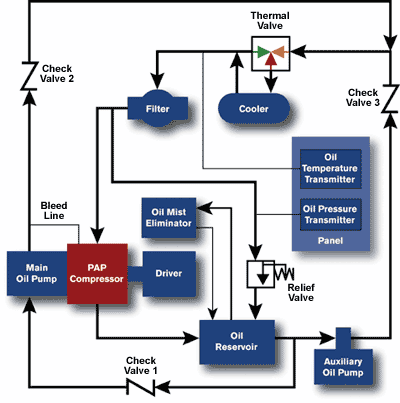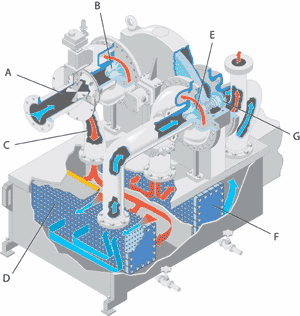Three Ways to Minimize Downtime in Your Shop Using Engineered Air
To ensure the most reliable, engineered air possible, one must consider system redundancy, accessibility and maintenance, and technological advances in control and monitoring.
Known as the fourth utility, compressed air is used in many facets of moldmaking, such as mold injection, cooling, powering high-speed machining and removing metal chips from the tools. Many shops employ compressed air systems in one capacity or another, and for the most part, these systems provide similar output. However, not all compressed air is the same. In several cases, specially engineered air is needed to power a variety of machinery and tools used specifically in moldmaking.
Engineered air is a term used to de-scribe compressed air tailored to meet specific industry needs—100 percent oil-free, particulate filtered and completely reliable. It goes beyond the simple output of compressed air at a specified pressure pounds per square inch. Engineered air provides the right type of air for the right application. To ensure the most reliable, engineered air possible, there are three details to consider: (1) system redundancy, (2) accessibility and maintenance, and (3) technological advances in control and monitoring.
System Redundancy
A redundant system eliminates the possibility of system failure. This will allow your shop to meet or even exceed production quotas. Look at key parts of your moldmaking operation to see where system redundancies might be useful. For example, compressed air is needed to inject a polymer into a hollow mold cavity. Within an air compressor, the oil pump is the heart of the lubrication system—it is what keeps the machine running smoothly. If your pump breaks down, the machine comes to a grinding halt. A redundant system would include not one, but two full capacity, full pressure pumps—one motor-driven auxiliary and the other a shaft-driven main.
During regular operations, the shaft-driven main works, while the motor-driven auxiliary is on perpetual stand-by for emergency situations, providing additional overall package protection. This type of system provides full capacity backup. Without this redundant system, in the event of an oil system malfunction, the entire compressor system needs to be shut down. A redundant system eliminates downtime and provides a reliable source of engineered air.
Accessibility and Maintenance
While requiring additional time and attention from your plant engineers, cleaning and maintenance are a sound investment. As with all other plant operating systems, compressed air systems that are cleaned and maintained are less likely to break down. Simply put, less downtime allows for more production. In addition, consistent cleaning and maintenance helps keep wear and tear to a minimum. This saves money in replacement parts.
Using an air compressor’s intercooler as an example, many manufacturers have designed the parts with accessibility and maintenance in mind. For instance, both U-shaped and straight intercooler tubes are industry practice. However, straight tubes are easier to clean than those with a U-bend design. A plant engineer can simply remove the water piping, unbolt the water box and rod the tubes in place. Rodding is not possible with U-bend tubes found in some compressors. In addition, intercooler tubes with a water-in-tube design are easier to clean and maintain than those with an air-in-tube design that require wire brush or chemical bath cleaning. Remember that the longer it takes to clean the intercooler, the longer your engineered airflow is down.
Another good example of important compressor parts that benefit greatly from diligent maintenance and cleaning are journal bearings. Journal bearings help provide a near frictionless environment to support and guide the rotating shaft. Properly installed and maintained, these bearings can last for extended periods of time. However, constant cleaning and maintenance help keep things running reliably. Horizontally split bearings are easier to maintain, clean and replace. A plant engineer simply needs to remove the top half of the gear case to service. No other disassembly is required. Some manufacturers use one-piece design bearings that require complete compressor disassembly for cleaning and maintenance.
Interchangeability of parts is another factor that contributes to ease-of-maintenance. Interchangeable parts save time and money. For example, multiple stage compressors use a bull gear and pinion system to power the impellers at each stage of air compression. The quality of the bull gears used directly determines whether or not they are interchangeable (see Quality Ratings Sidebar, page 41).
Technological Advances in Control and Monitoring
In many moldmaking shops, multiple compressors feed a single air system. The operation of these multiple compressors needs to be coordinated, monitored and controlled in order to accommodate the various compressed plant applications. An initial investment in innovative monitoring technology can ultimately pay for itself.
A PLC-based automatic sequencer can allow for up to eight separate compressor units to communicate with one another and operate as one. Multiple compressors are operated in sequence according to a programmed schedule. High-tech PLC-based automatic sequencers are capable of monitoring and matching compressor supply to demand. For example, they can select which compressors to use at any given time, shutting down those compressors not necessary to plant operations, even choosing backup units if needed. An automatic sequencer can turn multiple compressor systems into one, ensuring a stable system pressure, allowing your shop to run as efficiently as possible, saving both time and money.
There are several programmable logic controller (PLC)-based systems available. These PLC-based modular control systems can allow your plant operations engineers to remotely monitor and perform diagnostics checks on your compressed air systems, helping to you to predict and prevent any systems malfunctions that could result in stoppage of engineered air. This can save you money on repairs and replacements, as well as lost production time. As another cost saving feature, these control systems should be easy-to-operate, resulting in less time spent training your operations staff to use these technologically advanced monitoring systems.
Summary
Engineered air is created with a specific plant application in mind, to increase reliability and efficiency. Simply recognizing that engineered air is not the same as compressed air is only one step toward minimizing downtime and achieving better productivity. The systems that provide engineered air must be engineered, themselves, to provide this air as reliably as possible.
These three points can help your plant engineers to ensure the most reliable flow of engineered air possible:
- System redundancy, like a dual-pump oil system, ensures engineered air is always running at full capacity.
- Accessibility and maintenance lessens the wear and tear on key machine parts, keeping the system running smoothly.
- Technological advances in control and monitoring provides your plant engineers with the information they need to keep engineered airflow at a constant.
Related Content
Steps for Determining Better Mold Prices
Improving your mold pricing requires a deeper understanding of your business.
Read MoreMaking Mentoring Work | MMT Chat Part 2
Three of the TK Mold and Engineering team in Romeo, Michigan join me for Part 2 of this MMT Chat on mentorship by sharing how the AMBA’s Meet a Mentor Program works, lessons learned (and applied) and the way your shop can join this effort.
Read MoreEditorial Guidelines: Editorial Advisory Board
The Editorial Advisory Board of MoldMaking Technology is made up of authorities with expertise within their respective business, industry, technology and profession. Their role is to advise on timely issues, trends, advances in the field, offer editorial thought and direction, review and comment on specific articles and generally act as a sounding board and a conscience for the publication.
Read MoreThe Role of Social Media in Manufacturing
Charles Daniels CFO of Wepco Plastics shares insights on the role of social media in manufacturing, how to improve the “business” side of a small mold shop and continually developing culture.
Read MoreRead Next
How to Use Continuing Education to Remain Competitive in Moldmaking
Continued training helps moldmakers make tooling decisions and properly use the latest cutting tool to efficiently machine high-quality molds.
Read MoreReasons to Use Fiber Lasers for Mold Cleaning
Fiber lasers offer a simplicity, speed, control and portability, minimizing mold cleaning risks.
Read More




















